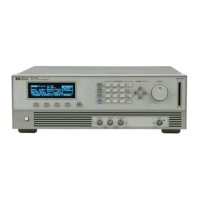3. On the
HP 8114A set up the OUTPUT page as shown in the
following illustration:
II
Per
1.00
lls
Out
ON
Inh OFF
f
DElZlY
50.0
I-IS
Basclne
+0.00
v
Width Fj@.@ns
l%plitd
mv
20.0
500
into
50.00
.--n--.
Positive
I
w-
Configuring the Output Page
4. Set the Digitizing Oscilloscope HP 54121T:
n
Press
(AUTOSCALE)
n Select the Display menu and set the Number of Averages to 64
m
Set the
VOLTS/DIV
= 10
mV/div
m
Set OFFSET to 1 V
n
Select the Timebase menu and set the TIME/DIV to 100
ps/div
w
Center the first positive-going edge of the signal (approximate
Delay = 98.5 ns)
5.
Press
m
and
(M]
6. Select the Window submenu and press [WINDOW MARKER
1)
and set
it to 980
mV
7. Press (WINDOW MARKER
21
and set it to 1 V
8. Select the Acquire submenu, set the Number of Samples to 1000
and press
CSTART
ACQUIRING)
9. After the data for the time histogram has been acquired
(#
Samples =
lOO%),
select the Result submenu
10. Press (MEAN) and [SIGMA). RECORD the values of sigma
11. The RMS-jitter is calculated as follows:
RMS -jitter =
Gsigma
-
delta.t.up
6
12. The RMS-jitter for delay of 50 ns is 50 ps. Enter the result in the
Test Report as TR entry 5.3
-
1
13. Set HP 8114A for delay of 500 ns
14. Repeat steps 9 to 12
Note
TIME/DIV
= 200
ps/div.
Approximate delay = 549 ns
15. The RMS jitter for delay of 500 ns is 175 ps. Enter the result in
the
Test
Report as TR entry 5.3
-
2
3.24
Testing the HP
g114A

